English language statistics give us a fascinating insight into the history of the language, how it is being used today around the world, and how it is going to evolve in the future.
From how many people speak English to the most-used words and letters in the language, we have compiled this curated list of facts and statistics about the English language in the world today so that you can find the information you need, all in one place.
Top global English language statistics
- There are an estimated 380 million native English speakers worldwide, and 1.5 billion people who speak English as a first or second language.
- The country with the highest number of English speakers is the United States of America.
- English is the official working language of 60% of multinational companies.
- The average word length in English is 4.79 letters.
- English is the third largest native language in the world, and is expected to remain so until at least 2050.

Statistics about English as a global language
Let’s begin by looking at English as a global language: how many people speak English worldwide, where do they speak it, and what do they use it for?
How many people speak English globally?
1.5 billion people speak English worldwide as of 2023, according to data compiled by Ethnologue.
This means that approximately 19% of the world’s population speaks English, making it the most widely spoken language around the globe.
The British Council’s Future of English report suggests that there are actually more like 2.3 billion English speakers worldwide, with over 1.9 billion people learning English or speaking it as a second language.
One of the great benefits of learning English is that it lets you communicate with all these people!
How many native English speakers are there worldwide?
There are 380 million native English speakers worldwide as of 2023.
The most common first language in the world is Mandarin Chinese, with 940 million native speakers. Spanish comes in second, with 485 million native speakers.
This makes English the third most widely spoken first language in the world.
Combining these English language statistics, we can see that English is the language with the most non-native speakers; over 1.1 billion people speak English as a second or foreign language.
The language with the next most second-language speakers is Modern Standard Arabic, with 274 million. Hindi has 266 million non-native speakers, and French has 229 million.
Only 4% of English conversations take place between native English speakers, according to a TEDx Talk by communication skills trainer Marianna Pascal. The other 96% involve at least one person speaking English as a foreign language.
How many English accents are there?
There are around 160 regional English accents around the world – one of the things that makes English hard to learn!
The UK has over 50 regional accents and dialects, more than any other country. The US has 27 distinct local accents, while Australia has 14 and Canada has 3.
There are also significant regional variations in India, the Caribbean, and South Africa; while other countries like Singapore, Hong Kong, the Philippines, and Malaysia all have their own English accents.
All of these accents occur, in part, because the English-speaking population is so widely dispersed around the world.
Countries with the most native speakers of English
Below you can see the top 10 English-speaking countries according to the number of people who speak English as their first language.
| Country | Population | Number of people who speak English as their first language | Percentage of people who speak English as their first language |
|---|---|---|---|
| United States | 341,089,347 | 258,513,070 | 78.1% |
| United Kingdom | 64,000,000 | 59,072,000 | 92.3% |
| Nigeria | 206,200,000 | 37,157,240 | 18.02% |
| Canada | 37,138,500 | 20,193,335 | 54.37% |
| Australia | 23,401,892 | 17,020,421 | 72.74% |
| South Africa | 52,981,991 | 4,930,510 | 9.31% |
| Ireland | 4,422,100 | 4,112,100 | 93.22% |
| New Zealand | 4,275,100 | 3,673,623 | 85.93% |
| Singapore | 4,044,200 | 1,953,348 | 48.3% |
| Indonesia | 279,118,866 | 837,356 | 0.3% |
Countries with the most English speakers (native and non-native)
The US remains top of the list when we look at the total number of English speakers, whether it is a first language or an additional language. Here are the statistics for the top 10 English-speaking countries:
| Country | Population | Number of people who speak English (native or non-native) | Percentage of people who speak English (native or non-native) |
|---|---|---|---|
| United States | 341,089,347 | 316,107,532 | 95.5% |
| India | 1,350,000,000 | 128,539,090 | 10.5% |
| Nigeria | 206,200,000 | 125,039,680 | 60.64% |
| Pakistan | 220,892,331 | 108,044,691 | 48.91% |
| Indonesia | 279,118,866 | 85,968,611 | 30.8% |
| Philippines | 110,000,000 | 64,025,890 | 58.2% |
| United Kingdom | 64,000,000 | 62,912,000 | 98.3% |
| Germany | 80,600,000 | 45,400,000 | 56% |
| Uganda | 44,270,000 | 39,800,000 | 89.9% |
| France | 67,500,000 | 38,643,750 | 57.25% |
Countries with English as the primary language
Here is a list of countries where English is the primary language:
Antigua and Barbuda, Australia, Barbados, Belize, Botswana, Canada, Dominica, Fiji, Ghana, Grenada, Guyana, Ireland, Jamaica, Kenya, Liberia, Malawi, Micronesia, New Zealand, Nigeria, Papua New Guinea, Saint Kitts and Nevis, Saint Lucia, Saint Vincent and the Grenadines, Sierra Leone, Singapore, Solomon Islands, South Africa, South Sudan, Tanzania, The Bahamas, The Gambia, Trinidad and Tobago, Uganda, United Kingdom, United States, Zambia, and Zimbabwe.
Many of these countries have other official languages, but English is the primary language used by the population.
This means that only around 5% of the world’s total population lives in a country where English is the primary language.
How many countries have English as an official language?
According to information published by the CIA, there are 57 countries and 26 territories that use English as an official language.
These are:
| North America | Anguilla, Antigua and Barbuda, Bahamas, Barbados, Belize, Bermuda, British Virgin Islands, Canada, Cayman Islands, Curaçao, Dominica, Grenada, Jamaica, Montserrat, Puerto Rico, Saint Kitts and Nevis, Saint Lucia, Saint Vincent and the Grenadines, Trinidad and Tobago, Turks and Caicos Islands, United States, United States Virgin Islands |
| Oceania | Australia, American Samoa, Cook Islands, Fiji, Guam, Kiribati, Marshall Islands, Micronesia, Nauru, New Zealand, Niue, Norfolk Island, Northern Mariana Islands, Palau, Papua New Guinea, Pitcairn Islands, Samoa, Solomon Islands, Tokelau, Tuvalu, Vanuatu |
| Africa | Botswana, Cameroon, Eswatini, Gambia, Ghana, Kenya, Lesotho, Liberia, Malawi, Mauritius, Namibia, Nigeria, Rwanda, Saint Helena, Ascension and Tristan da Cunha, Sierra Leone, South Africa, South Sudan, Sudan, Tanzania, Uganda, Zambia, Zimbabwe |
| Europe | Akrotiri and Dhekelia, Gibraltar, Guernsey, Ireland, Isle of Man, Jersey, Malta, United Kingdom |
| Asia | Christmas Island, Cocos (Keeling) Islands, Hong Kong, India, Pakistan, Philippines, Singapore |
| South America | Falkland Islands, Guyana |
Many of these – and plenty of other countries – speak English as a ‘lingua franca‘. This means that even if it is not an official language, it is widely adopted as a second language between speakers of other languages, especially in academia and business.
This is especially true in places where there are many different languages spoken in a concentrated area, and people need a common language to be able to communicate and conduct business. Europe is an excellent example of this.
Business English statistics
The British Council published a study in 2023 in which 51% of respondents said that English was the most important language for international business in the future.
And in research for their book The Future of English: Global Perspectives, they found that 92% of people said English was important to secure a job in their country.

According to Tsedal Neeley in her book The Language of Global Success, 60% of multinational companies use English as their official business language. The real number may be considerably higher, as some countries’ labor laws forbid the use of a foreign language as an official working language.
A study published by Cambridge English, based on data from 5,300 employers in 38 countries or territories, found that the vast majority (98.5%) of employers have a way of assessing candidates’ English competency. This includes:
- Interview in English: 32%
- English test taken at school: 19%
- Degree taught in English: 19%
- International English language certificate: 15%
- English test at interview (internally created): 13%
- English test at interview (externally provided): 11%
The survey found that around 50% of employers offer a better starting package to recruits with good English language skills.
They also reported that employees who speak good business English are more likely to progress faster through job grades (18%) and receive salary increases (17%).

Employers view the following language skills as most important:
- Reading: 38%
- Speaking: 35%
- Listening: 14%
- Writing: 12%
The demand for English as a global business language is reflected in the growth of the English language training market.
According to Technavio, this market is expected to grow by over $4.5 million between 2022 and 2027, achieving a CAGR of 5.75%. 50% of this growth will come from APAC.
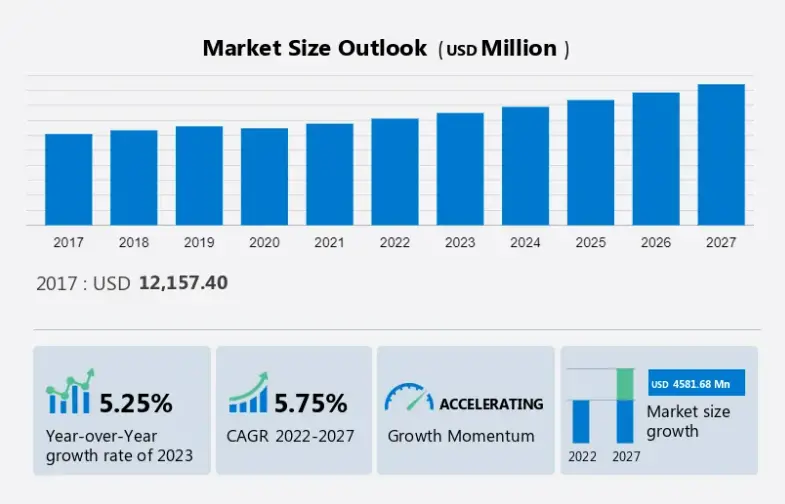
Further data from Business Research Insights values the global business English language training market at $19.7 billion in 2022, with predicted growth to almost $42 billion in 2031, representing a CAGR of 8.8%.
English is by far the most dominant language on the internet; over 50% of websites are published in English according to W3Techs. Spanish comes a distant second with 5.6%, as of February 2024.
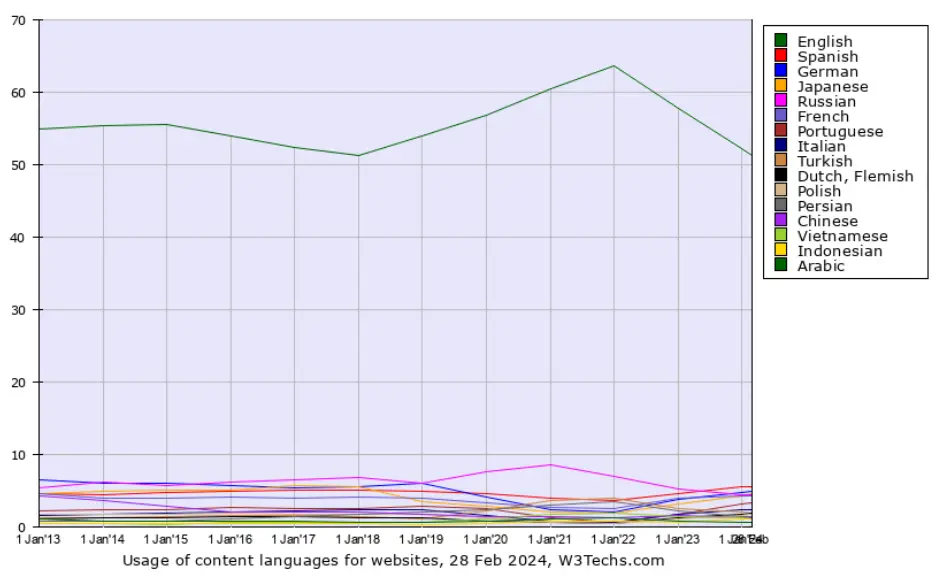
Taking a different approach to statistics about English usage on the internet, we see that English is the dominant language for internet users. However, the language is not as far ahead in this regard as it is when it comes to published content.
25.9% of internet users speak English as their first language, closely followed by Chinese at 25.3%.
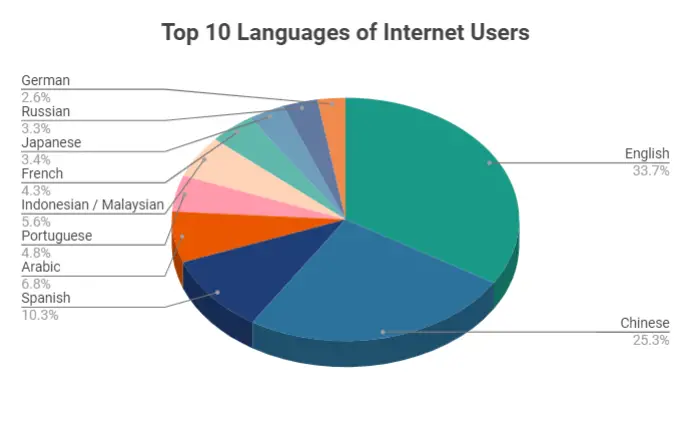
The English language also dominates science, with 98% of scientific papers being published in English.
Statistics about English words and letters
The following statistics related to the English language are all about the words and letters contained within it.
How many words are there in the English language?
There are 171,476 words currently in use in the English language, according to the Oxford English Dictionary. However, if you include archaic and technical words and all possible inflections, this number increases dramatically to over a million, according to some counts.
The good news for anyone learning English vocabulary is that you don’t need to know all these words to be considered fluent.
Research conducted in 2016 found that the average 20-year-old American knows 42,000 lemmas, which are base words that count all inflections of a word (e.g. talk, talking, talks, talked) as one.
Another study estimates the average vocabulary of a college student as 16,785 lemmas.
And in fact, the New General Service List (NGSL) is a list of 2,809 words which, its authors claim, covers 92% of most general English texts.
According to NGSL, these are the 20 most common words in English, and the number of times each one appears per million words:
| Word | Frequency per million words |
|---|---|
| the | 60910 |
| be | 48575 |
| and | 30789 |
| of | 30126 |
| to | 29272 |
| a | 27872 |
| in | 21142 |
| have | 14210 |
| it | 13772 |
| you | 12810 |
| he | 11017 |
| for | 10025 |
| they | 9764 |
| not | 9494 |
| that | 8653 |
| we | 8401 |
| on | 7763 |
| with | 7381 |
| this | 7003 |
| I | 6820 |
English word length statistics
There are two one-letter words in English: ‘A’ and ‘I’.
The longest words in English tend to be medical (Pneumonoultramicroscopicsilicovolcanoconiosis – 45 letters), fictitious (supercalifragilisticexpialidocious – 34 letters), or simply uncommon (antidisestablishmentarianism – 28 letters).
‘Incomprehensibilities’ is regarded as the longest word in common usage, with 21 letters.
While in his role as Director of Research at Google, Peter Norvig conducted an analysis of Google Books data that contained over 743 billion words.
He found that the average word length is 4.79 letters, with the following word length distributions:
| Word length | Percentage of words this length in the sample text |
|---|---|
| 1 | 2.998% |
| 2 | 17.651% |
| 3 | 20.511% |
| 4 | 14.787% |
| 5 | 10.700% |
| 6 | 8.388% |
| 7 | 7.939% |
| 8 | 5.943% |
| 9 | 4.437% |
| 10 | 3.076% |
| 11 | 1.761% |
| 12 | 0.958% |
| 13 | 0.518% |
| 14 | 0.222% |
| 15 | 0.076% |
| 16 | 0.020% |
| 17 | 0.010% |
| 18 | 0.004% |
| 19 | 0.001% |
| 20 | 0.001% |
| 21 | 0.000% |
| 22 | 0.000% |
| 23 | 0.000% |
Counting each word only once, the average word length was 7.60 letters.
The longest (commonly used) word with no vowels in English is ‘rhythms’.
Subdermatoglyphic, with 17 letters, is the longest word in English with no repeated letters, but it’s a dermatological term that few people will have the opportunity to use. Uncopyrightable, with 15 letters, is a more common example.
What letter is used the most in the English language?
The letter ‘E’ is the most-used letter in the English alphabet, appearing in 11.51% of words. The letter ‘S’ is the second most-used letter in English, and the most common consonant, appearing in 9.52% of words.
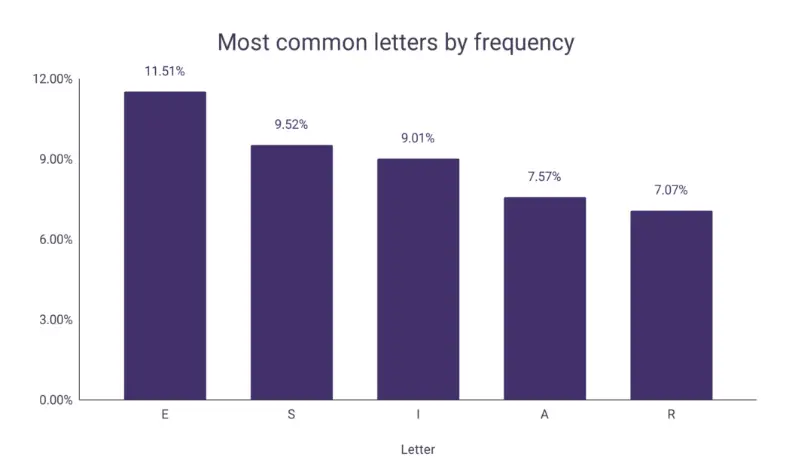
The letters ‘J’ and ‘Q’ are the least common, appearing in just 0.16% of words each.
The most common double letter is ‘SS’ (6.09% of words), followed by ‘LL’ (4.78%) and ‘EE’ (2.22%)
This data from WordsRated looks at the frequency according to the number of words that feature each letter.
Another analysis, based on the words found in the Concise Oxford Dictionary (9th edition, 1995), suggests the following most common letters in English:
| Letter | Percentage of dictionary words it appears in |
|---|---|
| E | 11.16% |
| A | 8.50% |
| R | 7.58% |
| I | 7.54% |
| O | 7.16% |
| T | 6.95% |
| N | 6.65% |
| S | 5.74% |
| L | 5.49% |
| C | 4.54% |
Another, perhaps more accurate, way to consider letter frequency is to look at how often a letter appears in a piece of text, since some words are used much more often than others.
An analysis from Cornell University looked at the frequency of letters in a 40,000-word text and found the following:
| Letter | Percentage of words it appears in, in a text of 40,000 words |
|---|---|
| E | 12.02% |
| T | 9.10% |
| A | 8.12% |
| O | 7.68% |
| I | 7.31% |
| N | 6.95% |
| S | 6.28% |
| R | 6.02% |
| H | 5.92% |
| D | 4.32% |
So, whichever way you look at it, the letter ‘E’ is the most common letter in the English language. When looking at usage in texts, the letter ‘T’ is bumped up the list because of its appearance in the most common word in the English language, ‘the’.
Additionally, Guinness World Records notes that the letter ‘S’ appears at the beginning of more words than any other letter, but the letter ‘T’ is the most common initial letter (used to begin a sentence).
How many English words come from other languages?
It’s estimated that almost 78% of English words have their origins in other languages, predominantly Latin and French (Scheder, 1977).
The remaining 22% are inherited from Old English, which stems from Germanic languages.
The table below shows the breakdown of word origins in English, as well as some examples from each category:
| Origin | % of words in English | Examples |
|---|---|---|
| Inherited from Old English/Germanic languages | 22.2% | brother, ache, green, thank, sand, life, foot, heat |
| French | 28.37% | beef, sauce, blue, orange, music, dance, government, dolphin |
| Latin | 28.29% | science, forum, compendium, city, paper, master, imagination, school |
| Greek | 5.23% | biology, democracy, atlas, data, idol, grammar, antique, economy |
| Scandinavian languages | 2.16% | ski, sauna, cozy, hug, husband, egg |
| Dutch, Low German, Frisian | 1.42% | landscape, easel, cookie, gin, drum, iceberg, ship |
| High German (inc. Yiddish) | 0.5% | silver, pastrami, schmuck, kosher |
| Celtic | 0.43% | pet, trousers, battle, brave, slogan, galore |
| Other Romance languages | 1.86% | canyon, tornado, alligator, guitar, pizza, emu |
| Other European languages | 0.13% | spruce, coach, paprika, pistol, robot |
| Proper names | 3.29% | cardigan, boycott, saxophone, mesmerize, leotard |
| Unknown etymology | 4.03% | blush, nugget, whale, prank, frog |
More fun facts about the English language
English is a generally positive language, according to a study published in 2012. The research looked at thousands of words from different sources and found the following percentages of positive language used:
- Books: 78.8%
- National media publications: 78.38%
- Social media: 72%
- Music lyrics: 64.14%
There are about 25,000 idioms in the English language, according to the London School of English. These multi-word phrases have non-literal meanings and can make the language rather confusing for potential learners.
Have you ever wondered how fast we speak English, compared to other languages? A 2011 study looked at the number of syllables spoken per second and found that English is slower-paced than Japanese, Spanish, French, and Italian, but faster than German and Mandarin.
In his book English Next, David Graddol reported that, based on data from the World Tourism Organisation, 22% of international tourism involves travel between one English-speaking country and one non-English speaking country.
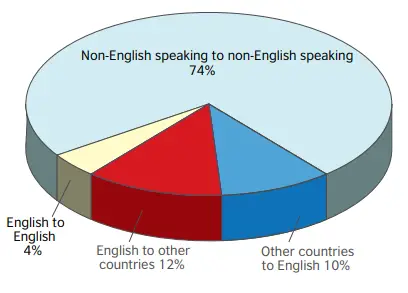
Of the 74% of travel that happens between two non-English speaking countries, much of it will still require the traveler to speak English as the default language between two non-native English speakers.
English is the most studied language in the world. According to the British Council, there were around 2 billion people learning English worldwide in 2023, and this figure was expected to remain stable for the next decade.
We explore more English language learner statistics in a separate article.
Statistics about English in the future
Many predictions have been made about how the English language will evolve in the future, and whether it will remain the dominant language among non-native speakers.
Back in 1985, British linguist David Crystal predicted that there were around 1 billion people who spoke English in the world, including non-native English speakers. Writing again in 2008, he increased that figure to closer to 2 billion, taking into account the emphasis on English language learning in countries like China and India.
He also predicted some changes to how the language is used. For example, because of the difficulty many English learners have pronouncing the ‘th’ sound in words like ‘this’ and ‘thin’, Crystal said he “wouldn’t be surprised” to see it disappear within 50 years, as it has already in Irish and Cockney accents.
Additionally, Crystal expects to see an increase in uncountable nouns being used as countable, such as ‘informations’ or ‘an information’. This would be a return to how they were used in Middle English, and in the works of Shakespeare and Chaucer.

Another linguist, David Graddol, wrote in his book The Future of English that he did not foresee any other language taking over as the world’s lingua franca in the next 50 years.
By 2050, English will still be the third-largest native language in the world, with 508 million native English speakers predicted.
Mandarin Chinese will remain in the number one spot, with 1.38 billion native speakers, but Spanish will drop from second to fourth place, being replaced by Hindi/Urdu with 556 native speakers.
Sources
List of countries by English-speaking population
List of countries and territories where English is an official language
Positivity of the English language
David Crystal: Two Thousand Million?
David Graddol: The Future of English
Tsedal Neeley: The Language of Global Success
When speaking a new language, what matters most is your attitude — not your accuracy
Toward a Meaningful Definition of Vocabulary Size
The Future of English: Global Perspectives
The frequency of the letters of the alphabet in English
English Letter Frequency (based on a sample of 40,000 words)
English Letter Frequency Counts: Mayzner Revisited
A cross-Language Perspective on Speech Information Rate



